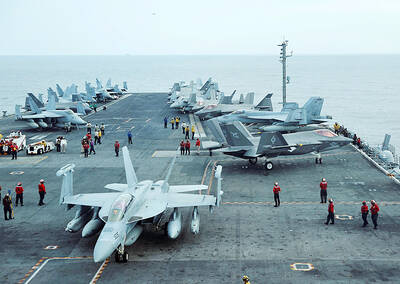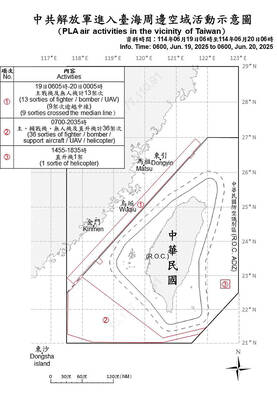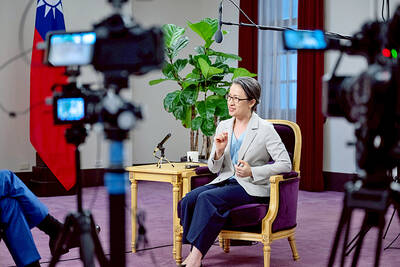A regulation to strengthen new structures against soil liquefaction would require developers of some buildings to survey geological conditions before construction, the Ministry of the Interior’s Construction and Planning Agency said.
A magnitude 6.4 earthquake that rocked southern Taiwan on Feb. 6, 2016, led to the collapse of Tainan’s Weiguan Jinlong complex, as well as many buildings of fewer than five stories, due to soil liquefaction, the agency said.
To prevent more damage from liquefaction, the agency plans to amend Article 64 of the Building Technical Regulations (建築技術規則), it said.
The change would require developers to survey underground conditions before constructing a building with fewer than five stories in an area with moderate to high liquefaction potential, the agency said.
Until the new regulation takes effect, developers are allowed to cite neighborhood surveys, it added.
Buildings with fewer than five stories typically have foundations with a depth of 2m, while buildings with one-story basements typically have foundations with a depth of 4m, Building Safety Certification Association director-general Tai Yun-fa (戴雲發) said on Saturday.
Sandy soil can be found at a depth of 20m in areas with high liquefaction potential, but buildings with shallow foundations remain more susceptible to liquefaction, especially when there is abundant groundwater or in the event of a massive earthquake, Tai said.
Over the past 12 years, the agency has approved construction permits for about 23,200 buildings annually, which means that the regulation might affect more than 20,000 buildings per year.
Experts have said that construction costs could soar after the regulation takes effect.
A geological survey and review can cost more than NT$1 million (US$32,422), which would be added to a building’s construction costs, New Taipei City Professional Civil Engineers Association chairman James Yu (余烈) said.
Housing prices would certainly rise due to the increased costs, Ba Ba Business chairman Huang Chiung-hui said.
Hualien County on Feb. 6 marked the first anniversary of a magnitude 6.0 earthquake that killed 17 people and injured nearly 300.
After Tamkang University reported that areas near the Milun Fault have high liquefaction potential, the county government said it asked the Cabinet for more than NT$300 million to survey the potential for soil liquefaction across the county.

China might accelerate its strategic actions toward Taiwan, the South China Sea and across the first island chain, after the US officially entered a military conflict with Iran, as Beijing would perceive Washington as incapable of fighting a two-front war, a military expert said yesterday. The US’ ongoing conflict with Iran is not merely an act of retaliation or a “delaying tactic,” but a strategic military campaign aimed at dismantling Tehran’s nuclear capabilities and reshaping the regional order in the Middle East, said National Defense University distinguished adjunct lecturer Holmes Liao (廖宏祥), former McDonnell Douglas Aerospace representative in Taiwan. If

TO BE APPEALED: The environment ministry said coal reduction goals had to be reached within two months, which was against the principle of legitimate expectation The Taipei High Administrative Court on Thursday ruled in favor of the Taichung Environmental Protection Bureau in its administrative litigation against the Ministry of Environment for the rescission of a NT$18 million fine (US$609,570) imposed by the bureau on the Taichung Power Plant in 2019 for alleged excess coal power generation. The bureau in November 2019 revised what it said was a “slip of the pen” in the text of the operating permit granted to the plant — which is run by Taiwan Power Co (Taipower) — in October 2017. The permit originally read: “reduce coal use by 40 percent from Jan.

‘SPEY’ REACTION: Beijing said its Eastern Theater Command ‘organized troops to monitor and guard the entire process’ of a Taiwan Strait transit China sent 74 warplanes toward Taiwan between late Thursday and early yesterday, 61 of which crossed the median line in the Taiwan Strait. It was not clear why so many planes were scrambled, said the Ministry of National Defense, which tabulated the flights. The aircraft were sent in two separate tranches, the ministry said. The Ministry of Foreign Affairs on Thursday “confirmed and welcomed” a transit by the British Royal Navy’s HMS Spey, a River-class offshore patrol vessel, through the Taiwan Strait a day earlier. The ship’s transit “once again [reaffirmed the Strait’s] status as international waters,” the foreign ministry said. “Such transits by

Taiwan is doing everything it can to prevent a military conflict with China, including building up asymmetric defense capabilities and fortifying public resilience, Vice President Hsiao Bi-khim (蕭美琴) said in a recent interview. “Everything we are doing is to prevent a conflict from happening, whether it is 2027 or before that or beyond that,” Hsiao told American podcaster Shawn Ryan of the Shawn Ryan Show. She was referring to a timeline cited by several US military and intelligence officials, who said Chinese President Xi Jinping (習近平) had instructed the Chinese People’s Liberation Army to be ready to take military action against Taiwan